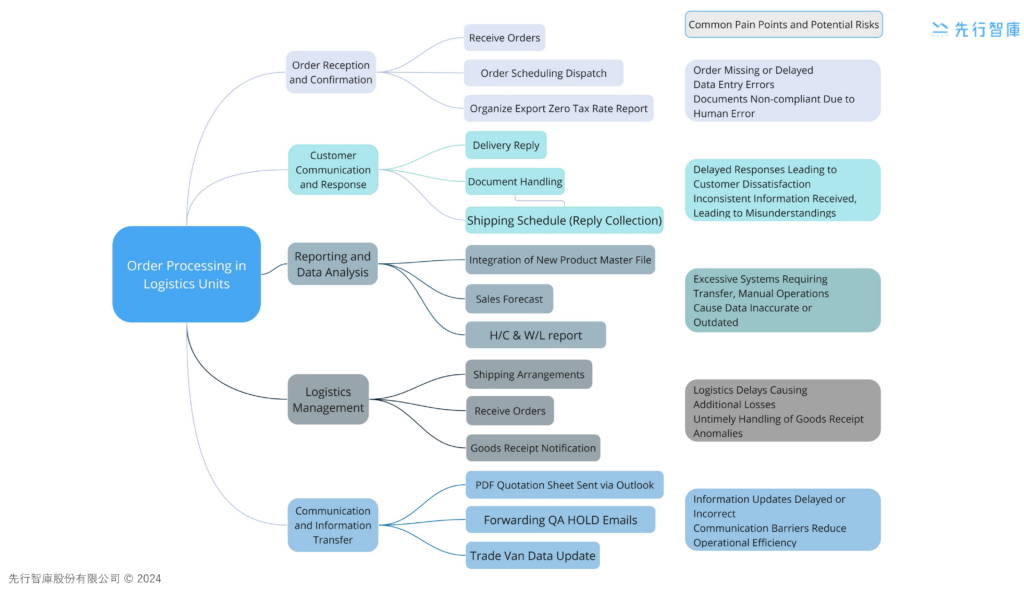With the continuous expansion of businesses and the increasingly competitive environment, logistics units face numerous challenges in order management processes. To address these challenges, process optimization and automation have become vital means to enhance efficiency and reduce costs. This article explores how optimization and automation assist logistics units in achieving more efficient order process management, focusing on order reception and confirmation, customer communication and response, reporting and data analysis, logistics management, and communication and information dissemination.

Process Stage One: Order Reception and Confirmation
Manual Workflow Steps:
- Regularly check emails for new orders.
- Manually extract order information from emails, such as order numbers and quantities.
- Input order information into the respective order management system for confirmation and processing.
Common Pain Points and Potential Risks:
Missed or lost orders leading to delays or losses.
- Human error in data entry leading to processing errors or additional costs.
- Data entry errors leading to incorrect order processing, increasing subsequent processing costs.
RPA Process Solution: Automated Integration of Emails and Order Management System
- Create an automated trigger process in Power Automate to archive email attachments to a folder once new orders are detected in the mailbox.
- Utilize Power Automate Desktop to automatically extract order data from the folder and input it into the order management system.
Quantitative and Qualitative Benefits:
- Time savings: Assuming 100 orders processed daily, with manual processing taking an average of 10 minutes per order, RPA implementation can save 70% of order processing time, resulting in approximately 700 minutes saved per day, significantly improving work efficiency.
- Increased accuracy: Reduced risk of human errors enhances order data accuracy, reducing subsequent costs.
- Improved on-time delivery rate: Decreased risk of missed or lost orders leads to improved on-time delivery rates, enhancing customer satisfaction.

Process Stage Two: Customer Communication and Response
Manual Workflow Steps:
- Manually respond to customer inquiries or requests.
- Manually process relevant documents or information based on customer requirements.
- If necessary, manually adjust delivery dates or other order details.
Common Pain Points and Potential Risks:
- Delayed responses leading to customer dissatisfaction.
- Inconsistent responses from different departments causing customer confusion and misunderstanding.
- Inconsistent information leading to order errors or customer complaints, damaging company reputation.
RPA Process Solution: Automation of Customer Feedback and Document Management
- Create a flow process in Power Automate to automatically archive emails containing specific keywords, such as customer requests to adjust delivery dates, to a team management report.
- Automatically notify the team via email or Teams messages of new customer requirements recorded in the team management report.
Quantitative and Qualitative Benefits:
- Increased customer satisfaction: Average weekly reduction of customer wait time by 3000 minutes, improving response speed and enhancing customer satisfaction.
- Improved internal coordination efficiency: Reduced risk of inconsistent responses from different departments enhances internal collaboration efficiency, reducing error costs caused by communication issues.
- Enhanced work efficiency: Approximately 5000 minutes of manual processing time saved per month allows employees to focus on higher-value tasks, increasing overall work efficiency.

Process Stage Three: Reporting and Data Analysis
Manual Workflow Steps:
- Manually extract required data from various systems.
- Manually perform data integration and analysis.
- Manually generate reports, including product master files and sales forecasts.
Common Pain Points and Potential Risks:
- Delayed decision-making due to manual data extraction.
- Inaccurate reporting leading to flawed business decisions.
- High time and effort investment in manual report generation.
RPA Process Solution: Automated Data Extraction and Report Generation
- Create an automation process in Power Automate Desktop to extract data from specified files, input it into the system, and automatically download reports.
- Utilize Excel macros for data manipulation by Power Automate Desktop to ensure report accuracy and visual appeal.
- Save generated reports to specified locations and attach them to emails for automatic distribution to stakeholders.
Quantitative and Qualitative Benefits:
- Increased data extraction efficiency: RPA implementation reduces data extraction time from various systems by 70%, saving approximately 2000 minutes per month and significantly enhancing work efficiency.
- Enhanced data accuracy: RPA processes significantly reduce the possibility of human errors, thereby increasing report data accuracy and reducing the cost and risk of subsequent error handling.
- Reduced decision-making time: Automated report generation and distribution shorten decision-making time, facilitating timely business decisions and improving operational efficiency.

Process Stage Four: Logistics Management
Manual Workflow Steps:
- Manually receive orders and arrange shipping and procurement.
- Manually notify relevant departments to proceed with procurement operations.
- Manually monitor logistics status and address any logistics delays or anomalies.
Common Pain Points and Potential Risks:
- Delayed responses leading to customer dissatisfaction.
- Inconsistent responses from different departments causing customer confusion and misunderstanding.
- Inconsistent information leading to order errors or customer complaints, damaging company reputation.
RPA Process Solution: Automation of Procurement Operations
- Create an automation process in Power Automate to trigger automatically when procurement notifications are received, sending them to relevant operatives.
- Utilize Power Automate Desktop to automatically extract information from procurement notifications and input it into the logistics management system.
- Set up appropriate notifications to automatically inform relevant departments to proceed with procurement operations.
Quantitative and Qualitative Benefits:
- Improved efficiency in automated procurement operations: With RPA, automated handling of procurement notifications saves 60% of processing time per operation, resulting in an average monthly saving of 1800 minutes, significantly enhancing procurement operation efficiency.
- Risk reduction: Automated processes reduce the risk of errors caused by manual operations, thereby minimizing the risk of logistics delays or procurement anomalies and ensuring on-time order delivery and smooth logistics operations.
- Increased collaboration efficiency: Automatic notification of relevant departments for procurement operations promotes internal departmental collaboration, reducing confusion and misunderstanding caused by communication errors and improving overall work efficiency.

Process Stage Five: Communication and Information Dissemination
Manual Workflow Steps:
- Manually forward PDF quotes and QA HOLD emails to relevant parties.
- Manually update Trade Van system data regularly.
- Manual communication with relevant departments to ensure information dissemination.
Common Pain Points and Potential Risks:
- Time-consuming and error-prone manual email forwarding and information dissemination.
- Oral communication prone to omissions or ambiguity.
- Delayed or erroneous information dissemination leading to subsequent processing errors or delays.
RPA Process Solution: Automation of Departmental Collaboration and Document Synchronization
- Create an automation process in Power Automate to trigger automatically when specific events occur.
- Set up actions in the process to automatically send notifications to relevant departments via Teams, email, or instant messaging tools.
- Include necessary information in notifications to ensure accurate and timely information dissemination to relevant personnel.
- Automatically update extracted data into the appropriate database or system to ensure data currency.
Quantitative and Qualitative Benefits:
- Increased efficiency in information dissemination: Through automation, daily time spent on manual email forwarding and information dissemination is reduced, saving approximately 1500 minutes per month, significantly improving information dissemination efficiency, and reducing the risk of errors.
- Enhanced communication efficiency: Automated notification functionality ensures accurate and timely information delivery to relevant personnel, reducing the risk of omissions or ambiguity in oral communication, thereby improving communication efficiency and accuracy.
- Improved data synchronization timeliness: Automatic data updates to systems ensure data currency, avoiding delayed or erroneous information dissemination that may lead to subsequent processing errors or delays, enhancing internal coordination smoothness.

Conclusion
Through the application of RPA automation technology in logistics order management, businesses can achieve process optimization and efficiency improvement. From order reception and confirmation, customer communication and response, reporting and data analysis, logistics management to communication and information dissemination, RPA automation solutions bring significant quantitative and qualitative benefits. However, through ongoing research into automation technology and continuous iteration of process management, there is an opportunity to realize automation solutions more aligned with current trends and demands, bringing about a dual improvement in operational efficiency and customer experience.
KSCC is a management consulting company in Taiwan. Our services include corporate in-house training, consulting, and leadership management.For more information about our corporate services, please feel free to visit our website: https://kscthinktank.com.tw/custom-training/
